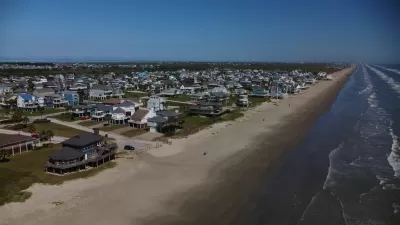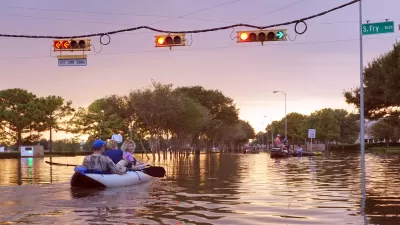Many experts believe that a property crash, as a result of Hurricanes or sea level rise, on the coast of South Florida is inevitable. But that hasn't deterred the suppliers or the consumers in the Miami real estate market.

A longform article by Nathalie Baptiste asks a big question of Florida's second-most populated city: "Why is Miami—America’s most vulnerable metropolis to sea-level rise—having yet another beachfront development boom?"
Baptiste begins by noting the current growth trend in the local development market: "The previous boom halted briefly after the 2008 collapse, but by 2011 it was on again. As of June 2015, more than 355 new towers have been proposed in South Florida." But the current optimism comes with great risk, which both consumers and suppliers seem completely blind to—whether willfully or not. Baptiste includes many pithy paragraphs to make this point, including the following:
The great cliche of the real estate business is that location is everything. That’s especially the case with buildings vulnerable to climate change. A truly green building is structurally sound, energy-efficient, low-cost, and in an area that isn’t vulnerable to sea-level rise and climate-change impacts. So a green building in a bad place is a bad building. In a place like greater Miami, the problem is both too many buildings in the wrong places, and standards that aren’t stringent enough.
Despite the billions of dollars in spending and years of planning it will take to prepare the Miami area for the effects of climate change is almost the opposite of what's happening in Miami, according to the story told in this article. Instead of planning and building safety measures, Miami is subsidizing flood insurance and incentivizing developers in risky areas.
FULL STORY: That Sinking Feeling

Alabama: Trump Terminates Settlements for Black Communities Harmed By Raw Sewage
Trump deemed the landmark civil rights agreement “illegal DEI and environmental justice policy.”

Planetizen Federal Action Tracker
A weekly monitor of how Trump’s orders and actions are impacting planners and planning in America.

Why Should We Subsidize Public Transportation?
Many public transit agencies face financial stress due to rising costs, declining fare revenue, and declining subsidies. Transit advocates must provide a strong business case for increasing public transit funding.

Understanding Road Diets
An explainer from Momentum highlights the advantages of reducing vehicle lanes in favor of more bike, transit, and pedestrian infrastructure.

New California Law Regulates Warehouse Pollution
A new law tightens building and emissions regulations for large distribution warehouses to mitigate air pollution and traffic in surrounding communities.

Phoenix Announces Opening Date for Light Rail Extension
The South Central extension will connect South Phoenix to downtown and other major hubs starting on June 7.
Urban Design for Planners 1: Software Tools
This six-course series explores essential urban design concepts using open source software and equips planners with the tools they need to participate fully in the urban design process.
Planning for Universal Design
Learn the tools for implementing Universal Design in planning regulations.
Caltrans
Smith Gee Studio
Institute for Housing and Urban Development Studies (IHS)
City of Grandview
Harvard GSD Executive Education
Toledo-Lucas County Plan Commissions
Salt Lake City
NYU Wagner Graduate School of Public Service





























